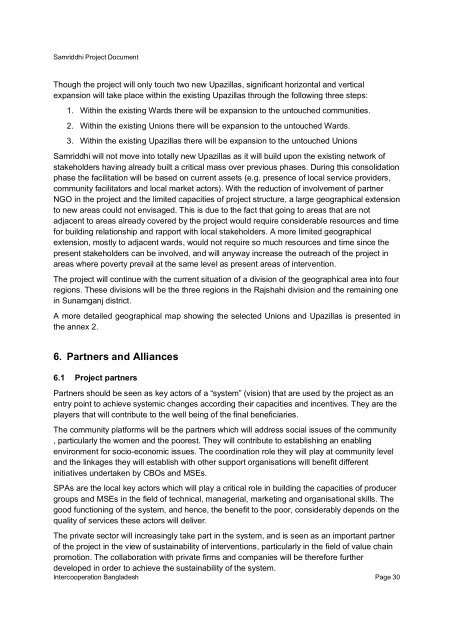Samriddhi
Samriddhi
Samriddhi
Create successful ePaper yourself
Turn your PDF publications into a flip-book with our unique Google optimized e-Paper software.
<strong>Samriddhi</strong> Project Document<br />
Though the project will only touch two new Upazillas, significant horizontal and vertical<br />
expansion will take place within the existing Upazillas through the following three steps:<br />
1. Within the existing Wards there will be expansion to the untouched communities.<br />
2. Within the existing Unions there will be expansion to the untouched Wards.<br />
3. Within the existing Upazillas there will be expansion to the untouched Unions<br />
<strong>Samriddhi</strong> will not move into totally new Upazillas as it will build upon the existing network of<br />
stakeholders having already built a critical mass over previous phases. During this consolidation<br />
phase the facilitation will be based on current assets (e.g. presence of local service providers,<br />
community facilitators and local market actors). With the reduction of involvement of partner<br />
NGO in the project and the limited capacities of project structure, a large geographical extension<br />
to new areas could not envisaged. This is due to the fact that going to areas that are not<br />
adjacent to areas already covered by the project would require considerable resources and time<br />
for building relationship and rapport with local stakeholders. A more limited geographical<br />
extension, mostly to adjacent wards, would not require so much resources and time since the<br />
present stakeholders can be involved, and will anyway increase the outreach of the project in<br />
areas where poverty prevail at the same level as present areas of intervention.<br />
The project will continue with the current situation of a division of the geographical area into four<br />
regions. These divisions will be the three regions in the Rajshahi division and the remaining one<br />
in Sunamganj district.<br />
A more detailed geographical map showing the selected Unions and Upazillas is presented in<br />
the annex 2.<br />
6. Partners and Alliances<br />
6.1 Project partners<br />
Partners should be seen as key actors of a “system” (vision) that are used by the project as an<br />
entry point to achieve systemic changes according their capacities and incentives. They are the<br />
players that will contribute to the well being of the final beneficiaries.<br />
The community platforms will be the partners which will address social issues of the community<br />
, particularly the women and the poorest. They will contribute to establishing an enabling<br />
environment for socio-economic issues. The coordination role they will play at community level<br />
and the linkages they will establish with other support organisations will benefit different<br />
initiatives undertaken by CBOs and MSEs.<br />
SPAs are the local key actors which will play a critical role in building the capacities of producer<br />
groups and MSEs in the field of technical, managerial, marketing and organisational skills. The<br />
good functioning of the system, and hence, the benefit to the poor, considerably depends on the<br />
quality of services these actors will deliver.<br />
The private sector will increasingly take part in the system, and is seen as an important partner<br />
of the project in the view of sustainability of interventions, particularly in the field of value chain<br />
promotion. The collaboration with private firms and companies will be therefore further<br />
developed in order to achieve the sustainability of the system.<br />
Intercooperation Bangladesh Page 30
















